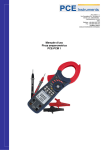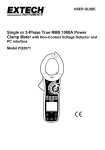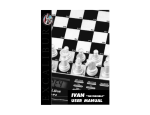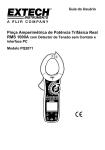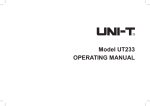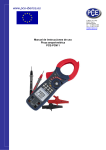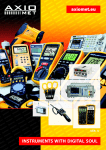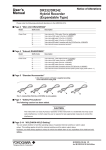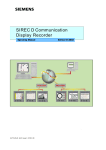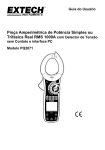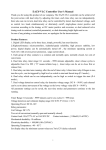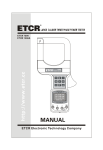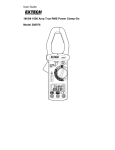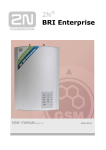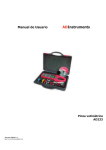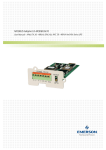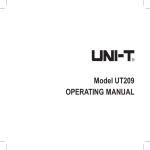Download OPERATING MANUAL
Transcript
USER MANUAL Clamp Meters ACM-2353 www.tmatlantic.com Overview This Operating Manual covers information on safety and cautions. Please read the relevant information carefully and observe all the Warnings and Notes strictly. Warning To avoid electric shock or personal injury, read the “Safety Information” and “Rules for Safe Operation” carefully before using the Meter. This clamp is a three phase intelligent handheld digital power clamp meter (hereafter referred to as “the Meter”) which has both the features of digital current meter and also power measurement meter. The Meter can measure Voltage, Current, Active Power, Apparent Power, Reactive Power, Power Factor, Phase Angle, Frequency, Active Energy and etc. 1 Unpacking Inspection Open the package case and take out the Meter. Check the following items carefully to see any missing or damaged part: Item 1 Description English Operating Manual Qty 1 piece 2 Red Test Lead 3 piece 3 Black Test Lead 1 piece 4 Red Alligator Clip 3 piece 5 6 Black Alligator 1 piece Clip USB Interface 1 piece Cable 7 Software 1 piece 8 Tool Box 1 piece 9 9V Battery 1 piece In the event you find any missing or damage, please contact your dealer immediately. 2 Safety Information This Meter complies with the standards IEC61010: in pollution degree 2, overvoltage category (CAT. III 600V, CAT IV 300V) and double insulation. CAT. III: Distribution level, fixed installation, with smaller transient overvoltages than CAT. IV CAT.IV: Primary supply level, overhead lines, cable systems etc. Use the Meter only as specified in this operating manual, otherwise the protection provided by the Meter may be impaired. In this manual, a Warning identifies conditions and actions that pose hazards to the user, or may damage the Meter or the equipment under test. A Note identifies the information that user should pay attention to. Rules For Safe Operation Warning To avoid possible electric shock or personal injury, and to avoid possible damage to the Meter or to the equipment under test, adhere to the following rules: zBefore using the Meter inspect the case. Do not use the Meter if it is damaged or the case (or part of 3 the case) is removed. Look for cracks or missing plastic. Pay attention to the insulation around the connectors. z Inspect the test leads for damaged insulation or exposed metal. Replace damaged test leads with identical model number or electrical specifications before using the Meter. z Do not apply more that the rated voltage, as marked on the Meter. z When measurement has been completed, disconnect the connection between the test leads and the circuit under test, remove the esting leads away from the input terminals of the Meter and turn the Meter power off. zDo not carry out the measurement when the Meter’s back case and / or battery door is opened to avoid electric shock. zWhen the Meter working at an effective voltage over 30V in AC, special care should be taken. zUse the proper terminals and functionyou're your measurements. zDo not use or store the Meter in an environment of high temperature, humidity, explosive, inflammable and strong magnetic field. The performance of the Meter may deteriorate after dampened. zDo not use the Meter if the surface of it is wet or the user’s hands are wet. zWhen using the test leads, keep your fingers behind the finger guards. 4 zReplace the battery as soon as the battery appears. With a low battery, the Meter indicator might produce false readings that can lead to electric shock and personal injury. zWhen opening the battery door, must make sure the Meter is power off. zWhen servicing the Meter, use only the same model number or identical electrical specifications replacement parts. zThe internal circuit of the Meter shall not be altered at will to avoid damage of the Meter and any accident. zSoft cloth and mild detergent should be used to clean the surface of the Meter when servicing. No abrasive and solvent should be used to prevent the surface of the Meter from corrosion, damage and accident. zThe Meter is suitable for indoor use. zTurn the Meter off when it is not in use and take out the battery when not using for a long time. zConstantly check the battery as it may leak when it has been using for some time, replace the battery as soon as leaking appears. A leaking battery will damage the Meter. 5 The Meter Structure A. The Meter Front Structure (see figure 1) Red Blue Figure 1 6 Yellow Black Transformer Jaw: designed to pick up the AC and DC current flowing through the conductor. 1 It could transfer current to voltage. The tested conductor must vertically go through the Jaw center. 2 3 4 Hand Guards: to protect user’s hand from touching the dangerous area. MR button (recall data) SEL / button (press to select phase and sum of Watts measurement) 5 MAXMIN / button 6 SAVE button (data store button) 7 LCD Display 8 L2 Input Terminal(Second phase measurement) 9 L3 Input Terminal (Third phase measurement) 10 COM Input Terminal 11 L1 Input Terminal (First phase measurement) 7 12 USB button 13 CLEAR button 14 LIGHT button (auto display backlight button) 15 button (Sum) 16 HOLD button 17 Rotary function switch 18 NCV indicate lamp B. The Meter Back and Bottom Structure (see figure 2) Figure 2 8 1 Infrared slot 2 USB Interface Cable FUNCTION Below table indicated for information about the functional button operations. Button Operation Performed zPress HOLD to enter the Hold HOLD mode any mode, Meter beeps. appears and the zPress HOLD again to exit the Hold mode to return to measurement mode, the Meter beeps and, disappears. Press the backlight button when needed. Auto shut-down backlight after lighting 20secs.Press the button again, turn the backlight off manually zAt Active power (main display) + Phase angle (secondary display) mode, press once button to sum up the current phase of 3 phase 9 measurement result. Then carry out second phase power measurement. zPress and hold for over 1 second to sum up the phase power measurement result which had been selected. z if you didn`t select any phase of 3 phase, is invaild. zPress once to store single reading, and the Meter beeps.The index number SAVE shown on the left secondary display keep on increasing. The maximum number of data store is 99, when it achieves 99, the Meter shows . zpress SEL button to step through first phase, second phase, third phase SEL and sum of watts. zPress SEL and hold for over 2 second to enter 3P3W mode. Press to start recording of maxinmum it MAXMIN valid at voltage, current, active power and apparent power ranges only. 10 zAt active energy range, press CLEAR and hold for over 1 second to reset time the zero, then restart the CLEAR timing. zAt all other ranges, press CLEAR and hold for over 1 second to clear stored readings. Press once to enter Memory Record MR appears and the Meter mode, beeps. zIf the Meter steps through sum of power press ႭႣ button to switch display of active power (main display) , sum of reactive power ႭႣ (secondary display) , sum of power factor (main display) and sum of apparent power. zIn the MR mode, press ႭႣ to select recoded data. USB Measurement data will be sent to the PC 11 1. Turn the rotary switch deasil to make the position away from the OFF position. Hearing a beep sound indicates the meter is turned on. The LCD displays all symbols firstly and then return to the normal mode. If the symbol is displayed, please changed the battery. 2. After auto-shut-off, there are some parts of the circuit of the meter which is still work. If no measurement needed in a longer time, you’d better turn the rotary switch back to the OFF position. 3. Press the backlight button when needed. Auto shut-down backlight after lighting 18secs.Press the button again, turn the backlight off manually Display Symbols (see figure 3) Figure 3 12 USB Data Output is in progress First phase symbol Second phase symbol Third phase symbol h Unit for hour mm Unit for minute HZ Hz: Hertz.The unit of frequency. PG PG: The unit of phase angle KVAr KVAr. The unit of reactive power W Watt: Sum of Watt The battery is low. Warning: To avoid false readings, which could lead to possible electric shock or personal injury, replace the battery as soon as the battery indicator appears. S Unit for second 13 MAX MIN Maxinum and Minimum reading Analogue Bar Graph Overloading Ruler CLEAR Indicator for clear the stored reading Negative symbol High voltage symbol AC MR Indicator for AC voltage or current Indicator for recall the stored reading Hz Frequency symbol MEM Indicator for data store FUL Indicator for data stored is full Data hold is active 14 Measurement Operation Preparation zDial the Rotary to any active measure range zReplace the battery as soon as the battery indicator appears on the display. zNon-Contact Voltage Detector WARNING: Risk of Electrocution. Before use, always test the Voltage Detector on a known live circuit to verify proper operation. 1. Rotate the Function switch to any measurement position. 2. Place the detector probe tip on the conductor to be tested. NOTE: The conductors in electrical cord sets are often twisted. For best results, move the probe tip along a length of the cord to assure placing the tip close to the live conductor. NOTE: The detector is designed with high sensitivity. Static electricity or other sources of energy may randomly trip the sensor. This is normal operation. 15 A. AC Voltage (main display) + Frequency (secondary display) Measurement (see figure 4) Red Blue Yellow Figure 4 The AC Voltage ranges are:100V, 400V and 750V The frequency range is:50Hz~60Hz To measure AC voltage + frequency, connect the Meter as follows: 1. Insert the red test lead into the L1, L2, L3 input terminal, and black test lead to the COM input terminal. 2. Dial the Rotary to VAC to select Voltage + Frequency range. 3. Connect the red test leads (L1, L2, L3 input terminal)to the corresponding three phases loaded live wire. Black test lead (COM input terminal) to the corresponding three phases loaded neutral wire. 16 4. Press SEL to select phase location, the display shows the corresponding phase symbol. L1 means the , L3 first phase , L2 means the second phase . means the third phase 5. The display shows the corresponding True RMS voltage value and frequency value of each phase. , it starts 6. Press MAXMIN, the LCD displays recording the maximum AC voltage True RMS value. , it starts 7. Press MAXMIN the LCD displays recording the minimum AC voltage True RMS value. Press MAXMIN again to show the current AC voltage True RMS value. 8. The display shows 0L when the input voltage is higher than 750V rms. Note When the measurement has been completed, disconnect the connection between the testing leads and the circuit under test and remove testing leads from the input terminals. 17 B. AC Current (main display) + AC Voltage (secondary display) Measurement (see figure 5) Figure 5 The AC current ranges are: 40A, 100A, 400A and 1000A The AC Voltage ranges are: 100V, 400V and 750V To measure AC current + AC voltage, connect the Meter as follows: 1. Dial the Rotary to AAC to select AC Curren + AC Voltage range. 18 2. Press the lever to open the transformer jaw. 3. Center the conductor within the transformer jaw, then release the Meter slowly until the trasnformer jaw is completely closed, Make sure the conductor to be tested is placed at the center of the transformer jaw, otherwise it will casue deviation. The Meter can only measure one conductor at a time, to meausre more than one condutor at a time will cause deviation. 4. The double display shows the AC current True RMS value and AC voltage True RMS value. , it starts 5. Press MAXMIN, the LCD displays recording the maximum AC current True RMS value. , it starts 6. Press MAXMIN, the LCD displays recording the minimum AC current True RMS value. Press MAXMIN, again to show the present AC current True RMS value. 7. The display shows 0L when the current of the tested conductor is higher than 1000A rms. Note When the measurement has been completed, disconnect the connection between the conductor under test and the jaw, and remove the conductor away from the transformer jaw of the Meter. 19 C. Active Power (main display) + Phase Angle (secondary display) Measurement Warning To avoid damages to the Meter or harms to you, do you measure higher than AC voltage 750 v and AC current 1000A. To measure active power + phase angle, connect the Meter as follows: 1. Diar the Rotary to KW to select Active power + Phase angle range. 2. Press the lever to open the transformer jaw, and clamp them to the corrresponding phase of tested conductor. If user needs to mesaure any phase of the 3 phase, then clamp them to that phase’s conductor. 3. Connecting method (see figure 6, 7, 8): 4. Insert red test leads to L1, L2, L3 input terminal and connecting it to every live wire of the 3 phase. 5. Insert black test leads to COM input terminal and connect it to the neutrual wire of the 3 phase. zWhen measuring 3 phase 4 wires, connecting the Meter as figure 6. 20 Red Blue Yellow Figure 6 Measuring instruction , see 1. Press SEL to choose first phase figure 7. The double displays show the acitve power kW value and the PG value of the second phase 1. Figure 7 21 If necessary, press to get the sum of watts as figure 8. Figure 8 2. After record the current power measurement value of the first phase, then press SEL to choose , The double display shows the value of acitve power kW and PG of the second phase 2. as figure 9 Figure 9 22 If ncessary, press to get the sum of watts as figure 10. Figure 10 3. After record the current power meaursuremnt value of the second phase, then press SEL again to choose , The double display shows the value of acitve power KW and PG of the third phase. as figure 11. Figure 11 23 If ncessary, press to get the sum of watts as figure12 Figure 12 4. After record the current power measurement value of the third phase, finally press and hold for 1seconds to display the 3 phase sum of acitve power value and apparent power value, as figure 13. Figure 13 Press as figure 14 to step through in sequence three 24 phase sum of active power+three phase sum of reacitve power, and three phase sum of power factor + 3 phase sum of apparent power. Figure 14 Press and hold for 1seconds again back to the normal measuring mode. In figure 6 W = W1 + W2 + W3. zWhen measuring 3 phase 3 wires, Hold SEL for 5 seconds and the Meter show , press SEL again for 5 seconds to exit 3 phase 3 wires ,connecting the Meter as figure 15. 25 Yellow Blue Red Figure 15 1. Insert red test leads to L1, L3 input terminal. 2. Insert black test leads to COM input terminal and connect it to the neutrual wire of the 3 phase. 3. Jump over the second phase measurement. 4. The first and the third phase measuring method is same as 3 phase 4 wires. In figure 15 W = W2 + W3. NOTE z It can only sum up the current measurement value. The maximum and minimum value cannot be summed up. zOnly at KW range can carry out sum of watts measurement, other ranges cannot carry out this measurement. zWhen testing has been completed, disconnect the connection between the testing leads and the circuit under test and remove testing leads from the input terminals. 26 D. Apparent Power (main display) + Reactive Power (secondary display) Measurement z Please refer to C E. Reactive Power (main display) + Apparent Power (secondary display) Measurement zPlease refer to C. F. Power Factor (main display) + Phase Angle (secondary display) Measurement Warning To avoid damages to the Meter or harms to you, do you measure higher than AC voltage 750V rms and AC current 1000A rms. To test for Power factor (main display) + Phase angle (secondary display), connect the Meter as follows: 1. Dial the Rotary to cos to select Power factor + Phase angle range. 2. Press the lever to open the transformer jaw, and clamp them to the corrresponding phase of tested conductor. If user needs to mesaure any phase of the 3 phase, then clamp them to that phase’s conductor. 3. The connecting method of 3 phases 4 wires or 3 phases 3 wires, refer to figure 6 and 15 4. When measuring 3 phase 4 wires: (see figure 18, 19 and 20) zPress SEL to choose the first phase , see figure 18. 27 Figure 18 The double display shows the first phase value of power factor PF and phase angle PG. Then press SEL again to choose the second phas, see figure 19. zPress SEL to choose the second phase , see figure 19. Figure 19 The double display shows the second phase value of 28 power factor PF and phase angle PG. Then press SEL again to choose the third phas, see figure 20. zPress SEL to choose the third phase , see figure 20. Figure 20 5. When measuring 3 phase 3 wires: zThe first phase and third phase operating method is same as 3 phase 4 wires. zJump over the second phase measurement. 6. MAXMIN button are not valid when measuring power factor. F. Active Energy (main display) + Time (secondary display) Measurement Warning To avoid damages to the Meter or harms to you, do you measure higher than AC voltage 750V rms and AC current 1000A rms. To test for Active Energy (main display) + Time (secondary display), connect the Meter as follows: 29 1. Dial Rotary to ENERGY range. 2. Press the lever to open the transformer jaw, and clamp them to the corrresponding phase of tested conductor. If user needs to mesaure any phase of the 3 phase, then clamp them to that phase’s conductor. 3. The connecting method of 3 phase 4 wires and 3 phases 3 wires, see figure 6 and 15 4. Press SEL to choose one of the three phases, see figure 21. Figure 21 zThe double display shows the value of tested object’s active engergy kWh value and the measuring time of the corresponding phase. zThe measuring reading gets increasing along with the time increases. Press HOLD to read a particular time kWh value. Then the reading and time are locked, but still continuous accumulate measuring time. zAfter read the data, press HOLD again to continous measurement. kWh value continous accumulate and the measuring time jumps to the present measuring time. 30 zWhen the measuring time is over 24 hours or the Meter is switched to other measuring ranges, active energy measuring will stop. zThe maximum readinng of acitve energy is 9999kWh. OL will be displayed when the reading is over than that. 5. MAXMIN are not valid when measuring active energy. 6. Press CLEAR and hold for 1 seconds to reset the time and energy. Note zWhen there is no input signal, it cannot carry out active energy measurement. zWhen testing has been completed, disconnect the connection between the testing leads and the circuit under test and remove testing leads from the input terminals. True RMS Measurement and Average Value Measurement The True RMS measurement method can measure accurately the effective value of non-sine wave input signal. Average value measurement method can measure the mean value of one sine wave input signal, and then displays it as RMS value When the input waveform has distortion, measuring tolerance will be included. The total tolerance depends on the total distortion. Below table 1 shows the waveform coefficient and the relationship and the requested changing factor of sine wave, square wave, 31 pulse rectangle wave, sawtooth triangle wave, RMS value and average value. The clamp Meter software designning base on the following formula: ¾ KW = KVA × Cos ¾ KVAr = KVA × Sin 2 2 ¾ KVA = KW KVAr 32 Accurate Specifications Accuracy: (a% reading + b digits), guarantee for 1 year. Operating temperature: 23°C±5°C Operating humidity: 45~75%R.H A. AC Voltage (True RMS) Range Reso Accuracy lution Allowable Input Frequency Maximum Imped Range overload ance protection voltage 100V 0.1V s 750 RMS (1.2%+5) 10M 50Hz~200 Hz 400V 750V B. Frequency Range Resolution Accuracy 50Hz~200Hz 1Hz s(0.5%+5) 33 C. AC Current (True RMS) Range Resolution Accuracy Allowable Maximum overload protection current Frequency Range s(2%+5) 1000A RMS 50Hz~60Hz 40A 100A 0.1A 400A 1000A 1A D. Active Power ( W=V x A x COS˥ ) Current / Voltage Current Voltages Range 100V 400V 750V 40A 4.00KW 16.00KW 30.00KW 100A 10.00KW 40.00KW 75.00KW 400A 40.00KW 160.0KW 300.0KW 1000A 100.0KW 400.0KW 750.0KW Range Accuracy s(3%+5) Resolution <1000KW: 0.01KW 100kW: 0.1KW 34 E. Apparent Power (VA = V x A) Current / Voltage Current Voltages Range 100V 400V 750V 40A 4.00KVA 16.00KVA 30.00KVA 100A 10.00KVA 40.00KVA 75.00KVA 400A 40.00KVA 160.0KVA 300.0KVA 1000A 100.0KVA 400.0KVA 750.0KVA Range Accuracy s(3%+5) Resolution <1000KVA: 0.01KVA 100kW: 0.1KVA 35 F. Reactive Power (Var = V x A x SIN˥ ) Voltages Range Current / Voltage Current Range 750V 100V 400V 40A 4.00KVAr 16.00KVAr 30.00KVAr 100A 10.00KVAr 40.00KVA 75.00KVAr 40.00KVAr 160.0KVAr 300.0KVAr 100.0KVAr 400.0KVAr 750.0KVAr 400A 1000A Accuracy s(3%+5) Resolution <1000KVAr: 0.01KVAr 100kW: 0.1KVAr G. Power Factor (PF = W / VA) Range 0.3~1 (capacitive or inductive) 0.3~1 (capacitive or inductive) Accuracy s0.022 Resolution 0.001 For reference only 36 Measuring Condition The minimum measuring current 10A The minimum measuring voltage 45V Measuring current less than 10A OR Measuring voltage less than 45V H. Phase Angle (PG=acos (PF)) Range Accuracy Resolution Measuring Condition O 0 ~90 O ±2 O 1 O (capacitive or The minimum measuring inductive) current 10A The minimum measuring voltage 45V O 0 ~90 O For reference only Measuring (capacitive or current less inductive) than 10A OR Measuring voltage less than 45V I. Active Energy (kWh) Range Accuracy Resolution 1~9999kWh ±(3%+2) 0.001kWh Remarks: zAllowable maximum overload protection voltage: 750V RMS zAllowable maximum overload protection current: 1000A RMS 37 SPECIFICATIONS Basic Functions Range Best Accuracy AC Voltage 100V/400V/750V s(1.2%+5digits) AC Current 40A/100A/400A/1000A s(2%+5 digits) Active Power 0.01kW-750kW s(3%+5 digits) Apparent Power 0.01kVA-750kVA s(3%+5 digits) Reactive Power 0.01kVAr-750kVAr s(4%+5 digits) 0.3~1(Capacitive or Power Factor Inductive ) O O s(0.02+2 digits) O Phase Angle 0 ~90 s2 Frequency 50Hz-200Hz ෭ Active Energy 0.001~9999 kWh s(3%+2 digits) O O O O -50 C~1300 C Temperature -58 F~2372 F Special Functions Auto Ranging ෭ Single-phase 2-wire ෭ ෭ Balance 3-phase 3-wire 38 3-phase 4-wire ෭ True RMS AC Voltage or Curren ෭ Data Logging 99 ෭ Data Recall ෭ Max/Min Mode ෭ Data Hold ෭ USB ෭ Display Backlight ෭ Full Icon Display ෭ Sleep Mode ෭ Low Battery Display ෭ Around 10MW ෭ Max. Display 9999 ෭ Analogue Bar Graph ෭ Input Impedance for ACVoltage Measurement 39








































